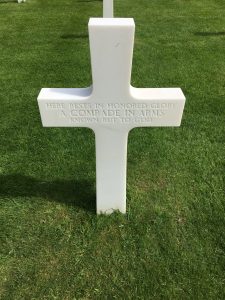In the view of this American history student, France has been massaging the Anglo-American narrative of World War II to suit their purposes. Rather than emphasizing their victimization by Germany, France’s national war museum, the Musee de l’Armee, plays up their involvement in the war after the capitulation of France. I do not dispute that Free France fought in the war, but for them to call themselves a victor of the war and to include De Gaulle among the likes of Churchill, Roosevelt, and Stalin misleads visitors of the museum. The French view that they were a victor of World War II is very prevalent in the war museum in Paris, Les Invalides. The building itself was once the military hospital and hospice for soldiers and veterans, but now houses the Musee de l’Armee, among other museums, and Napoleon Bonaparte’s tomb. The impressive World War I section showcased many of the weapons used by both sides and discussed broad strategy. The information presented about World War II, starting with their interpretation of the Fall of France, convinced me less. The Musee de l’Armee treats the German invasion of France as a conventional defeat, rather than the surrender of the nation and the creation of a collaborative French government. It also emphasizes the small successes the French achieved during the invasion, like the Maginot Line not surrendering to the Germans or the escape of French troops from Europe. The museum fails to mention that many of the French soldiers that escaped at Dunkirk returned to France soon after and were captured by the Germans or that the Maginot line was bypassed completely and rendered useless. It also does not mention that while the French inflicted over 100,000 casualties among the Germans, they suffered almost twice as many, not including the 1.5 million troops taken prisoner after the surrender was made official. There even is a lack of information that points to France’s reluctance to aid the Allies. Events such as the British sinking a French fleet for refusing to join them against the Germans after the fall of France and the rise of the Vichy Regime are glossed over in the museum. Pictured below is the part of Les Invalides containing Napoleon’s tomb.
Museums in Normandy tell a tale of World War II different from their Parisian counterparts. Be it their strong connection to the Allied forces that came in June of 1944 or their dedication to the friends and family they lost during the liberation, the Norman museums adhere more closely to the narrative of World War II widely accepted by the US and UK. Another possible explanation for this narrative being used in Normandy is that the D-Day invasion beaches are visited by large numbers of US and British citizens. The Utah Beach museum was one of the most comprehensive that I have been to. Its small but detailed collection of artifacts, scale models and restored vehicles, including an absolutely beautiful B-26 Marauder medium bomber, really helped give a concrete sense of what the soldiers were dealing with in the campaign. The narrative it tells follows closely with what I learned in my extensive research of the beach landing. The Arromanches 360 Theater showed a film that gave a very good sense of the war by showing actual footage. While shorter than I expected, the film shows the Normandy campaign and highlights the hard fighting the Allied forces faced, but also the price the Normans paid during the bombings for their liberation. Below is a picture of Utah Beach during a rising tide. The picture highlights how little the troops landing on the beach had to work with as the tide rose.
Not all museums in Normandy are so well done, however. The town of St. Mere Eglise, a vital crossroads in the Utah Beach invasion, was seized by the 82nd Airborne on D-Day and remained in their hands until relief from the beach reached the town. US control over the town was vital for the survival of the beachhead at Utah and many of the 82nd spent their lives taking and defending it. The town currently makes this history central to its identity, going so far as to hang a mannequin of a paratrooper from their church steeple. The museum for the airborne, located in the town, is insensitive in the presentation of information by using interactive videos and games on tablets to disseminate the information. This is great for children, as it keeps them engaged with subject matter and exploring the museum, but I fear that it makes the topics discussed seem light hearted. The tablets make the Normandy invasion seem like part of a game and detract from the seriousness of the topic and I fear that many who visit the Airborne museum in St Mere Eglise will take away the wrong message, or worse, nothing at all. The picture below is the church of St Mere Eglise. If you look at the top left of the church, you can see the parachute of the mannequin, and below that is the mannequin itself.

























































